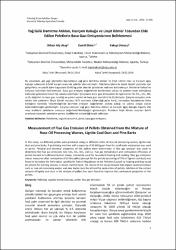| dc.contributor.author | Atay, Orhan Alp | |
| dc.contributor.author | Ekinci, Kamil | |
| dc.contributor.author | Umucu, Yakup | |
| dc.date.accessioned | 2017-07-21T11:53:28Z | |
| dc.date.available | 2017-07-21T11:53:28Z | |
| dc.date.issued | 2016 | |
| dc.identifier.uri | https://hdl.handle.net/20.500.11776/2030 | |
| dc.description.abstract | Bu çalışmada, gül yağı işlemeden kaynaklanan yağ gülü damıtma atıkları ile linyit kömür tozu ve kızılçam ağaç kabuğu kullanarak 6 farklı karışım oranında peletler elde edilmiştir. Peletleme işlemi ile küçük ölçekli işletmeler için geliştirilmiş ve saatlik işlem kapasitesi 50-60 kg pelet olan bir peletleme makinesi kullanılmıştır. Peletlerin fiziksel ve kimyasal özellikleri belirlenmiştir. Baca gazı emisyon değerlerinin belirlenmesi amacı ile peletler evsel ısıtmalarda kullanılan geleneksel kovalı tip sobada yakılmıştır. Çalışmada, baca gazı emisyonları ile ilgili olarak CO, CO2, SO2, NOx ve O2 değerleri ile baca gazı sıcaklığı ve yanma verimi bir baca gazı analizörü ile ölçülmüştür. Çalışma sonuçları, elde edilen tüm peletlerin (linyit kömür tozunun %75 oranında kullanıldığı pelet hariç) Isınmadan Kaynaklanan Hava Kirliliğinin Kontrolü Yönetmeliği’nde belirtilen emisyon değerlerinin altında kaldığı ve yakma amaçlı olarak kullanılabileceğini göstermiştir. Çalışma sonuçları yağ gülü damıtma atıkları ve kızılçam ağaç kabuğu organik atık veya artıkların peletleme amacıyla değerlendirilebileceğini göstermiştir. Peletlere linyit kömür tozunun belirli oranlarda ilavesinin peletlerin yanma özelliklerini iyileştirdiği tespit edilmiştir. | en_US |
| dc.description.abstract | In this study, six different pellets were produced using six different ratios of rose oil processing wastes, lignite coal dust and pine barks. A pelletizing machine with a capacity of 50-60 kg per hour for small-scale enterprises was used to pellet. Physical and chemical properties of the pellets were determined. A flue gas analyzer was used to determine the flue gas emissions (CO, CO2, SO2, NOx and O2), flue gas temperature and combustion efficiency of pellets burned in traditional bucket stoves, commonly used for household heating and cooking. Flue gas emissions values measured after combustion of all the pellets (except for the pellets consisting of 75% of lignite coal dust) was found to be below the limit values specified in Turkish Regulation on Air Pollution Caused by Heating and they could be utilized for burning process in stoves. Furthermore, the results of the study showed that organic wastes/residues such as rose oil processing wastes and pine barks could be utilized for production of pellets. Addition of the certain amount of lignite coal dust in the mixture of pellets has been found to improve the combustion properties of the pellets. | en_US |
| dc.language.iso | tur | en_US |
| dc.publisher | Namık Kemal Üniversitesi, Ziraat Fakültesi | en_US |
| dc.rights | info:eu-repo/semantics/openAccess | en_US |
| dc.subject | Peletleme | en_US |
| dc.subject | organik atık/artık | en_US |
| dc.subject | pelet | en_US |
| dc.subject | baca gazı emisyonu | en_US |
| dc.subject | Pelleting | en_US |
| dc.subject | organic waste/residues | en_US |
| dc.subject | pellet | en_US |
| dc.subject | flue gas emission | en_US |
| dc.title | Yağ Gülü Damıtma Atıkları, Kızılçam Kabuğu ve Linyit Kömür Tozundan Elde Edilen Peletlerin Baca Gazı Emisyonlarının Belirlenmesi | en_US |
| dc.title.alternative | Measurement of Flue Gas Emission of Pellets Obtained from the Mixture of Rose Oil Processing Wastes, Lignite Coal Dust and Pine Barks | en_US |
| dc.type | article | en_US |
| dc.relation.ispartof | Tekirdağ Ziraat Fakültesi Dergisi | en_US |
| dc.department | Tekirdağ Namık Kemal Üniversitesi Dergileri | en_US |
| dc.authorid | 3780 | en_US |
| dc.authorid | 20155 | en_US |
| dc.identifier.volume | 13 | en_US |
| dc.identifier.issue | 2 | en_US |
| dc.identifier.startpage | 1 | en_US |
| dc.identifier.endpage | 9 | en_US |
| dc.relation.publicationcategory | Makale - Ulusal Hakemli Dergi - Başka Kurum Yazarı | en_US |



















